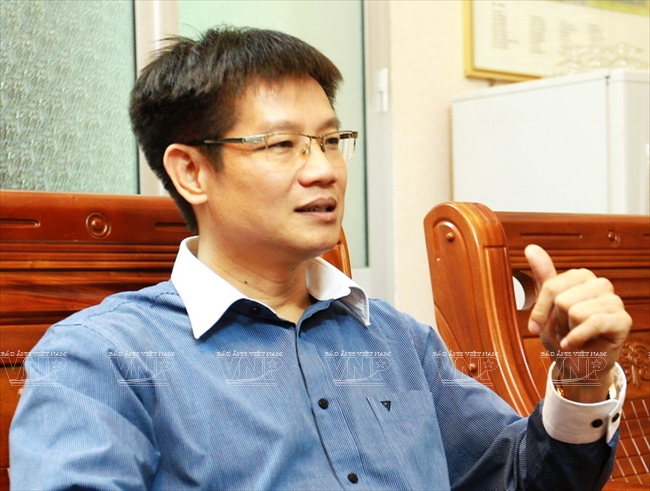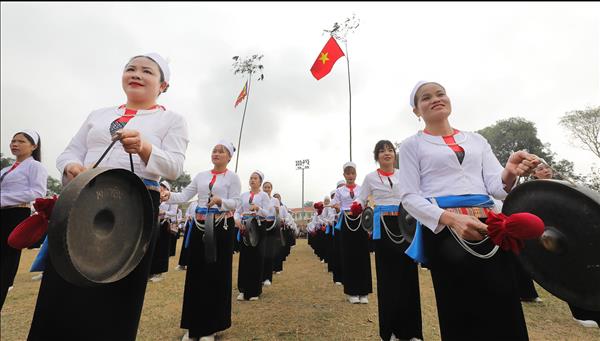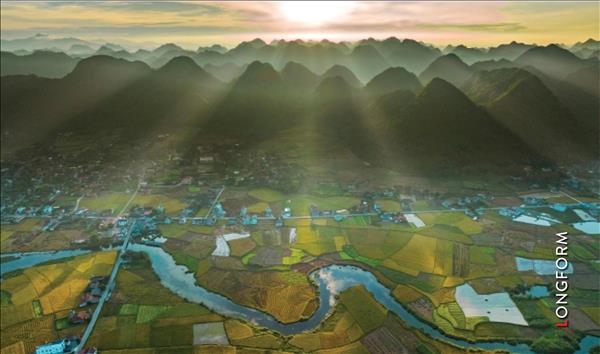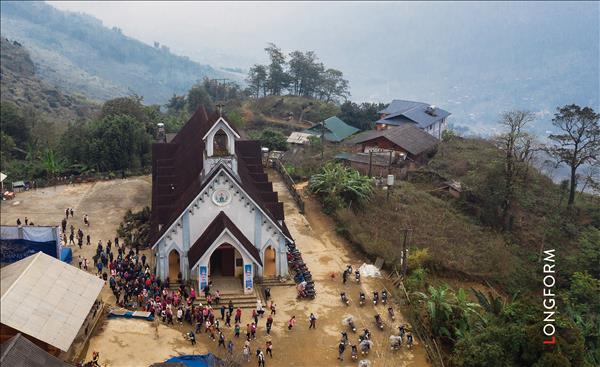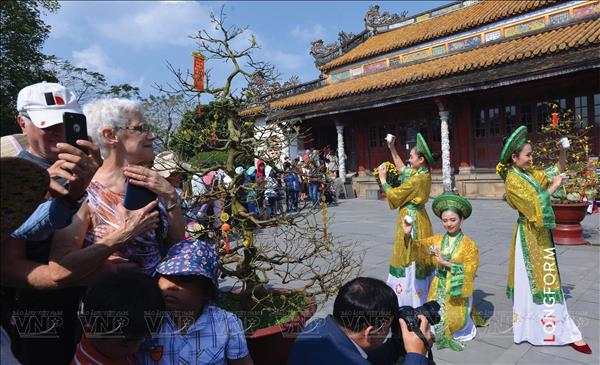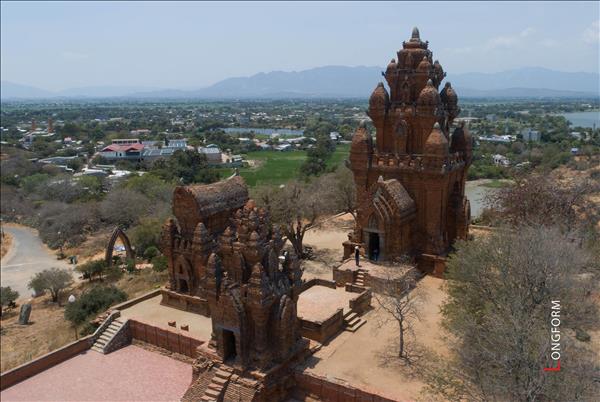Gnawing of time
Hue is a very sunny area with much rain and harsh weather. It suffers from natural disasters and floods every year. The severe devastation of the two wars against the French and the US, and the indifference of people to earn their living have caused great damage and loss to the complex of Hue monuments.
The damage continued from day to day and a researcher on Hue said: “The gnawing of time can waste away the entire Hue Imperial Citadel.”
In the terrible flood in 1999, the entire imperial city of Hue was suddenly submerged under water. Many palaces and temples were immersed in floodwater for a long time, causing the wood and tiles to become severely deteriorated and rotten. Even some sections of the walls of Hue Citadel and palaces were damaged by floodwater. In 1985, a big storm devastated Hue and damaged many royal architectural works, making the area look like a battlefield.
I am a native of Hue. During the days I was in my native land, almost every year I witnessed several floods. Sometimes, the water of the river rose high, overflowed the banks and rushed through the citadel gates of An Hoa, Chanh Tay, Huu and Nha Do, seemingly being able to sweep away all palaces and houses.
In the 80s the entire imperial city of Hue was almost full of weeds. People in this area came to seek firewood, dug in the earth to find waste and graze cattle. They built houses, reclaimed land to cultivate vegetables and crops and did many jobs to earn a living. As a result, the deteriorated architectural works became more desolate and ruined.
Over time, these works were more and more damaged, and were even at risk of complete collapse if they were not protected in time.
A journey to rescue the heritage of Hue residents
Shortly after UNESCO recognised the Complex of Hue Monuments as a World Cultural Heritage Site, the authorities of Thua Thien Hue Province assigned the Hue Monuments Conservation Centre to develop a plan to restore, embellish and conserve this huge heritage site.
Under UNESCO’s regulations, after the Complex of Hue Monuments was recognised as a World Heritage Site, every two years UNESCO inspected the restoration and preservation of this heritage site. From 2006 to 2012, Hue annually submitted a report on the restoration and preservation of the heritage site to UNESCO and received high praise from the organisation. Therefore, in 2013 UNESCO took the Hue monuments off the list of heritage sites which should be monitored. UNESCO has repeatedly asked Hue to send experts to join the International Council on Monuments and Sites (ICOMOS) under UNESCO’s World Heritage Committee, but for many different reasons, Hue has not yet sent the experts to join this prestigious organisation.
Over 22 years since the Complex of Hue Monuments was recognised as a World Cultural Heritage Site by UNESCO, the Hue Monuments Conservation Centre has done a huge job of restoration. It has restored and embellished hundreds of important architectural items, including the citadel area like Ngo Mon, Thai Hoa Palace, Hien Lam Cac, The Mieu, Dien Tho Palace, Duyet Thi Duong, Truong Sanh Palace, Tu Phuong Vo Su Palace and Truong Lang system (a long corridor in Tu Cam Thanh).
After more than 90 years since Ngo Mon, the main gate of the citadel, a grandiose work considered the symbol of Hue, was largely restored in 1923 on the occasion of congratulating King Khai Dinh (1916 - 1925) on his longevity, now the Hue Monuments Conservation Centre is conducting a new restoration.
According to Dr. Phan Thanh Hai, Director of the centre, over nearly a century, under the harsh weather and the devastation of the bombing, many items, especially the wooden components have been seriously degraded. The current restoration includes not only repairs and protection but also the extension of the life of this important work.
The centre has mobilised a contingent of the most skilled professionals, artisans and craftsmen from Hue and the country, including foreign experts and using the most modern technology, to restore Ngo Mon.
Hue has applied the world’s optimal restoration technology. It is the technology of Japan, a country experienced in the restoration of ancient architectural works, especially the wooden works like those of the Hue court. Thanks to this technology, the experts can disassemble all components that should be repaired to check and work out measures to deal with the damage inside the structures.
According to Tran Van Huong who is in charge of Ngo Mon restoration technology, the process of restoration is strictly supervised by the Hue Monuments Conservation Centre to ensure that all details, even the smallest details, be exactly the same as the original. If very small items, such as the brass rivets used to assemble the wooden trusses, are improperly assembled, the supervisors require reassembling them, even though these items are hidden.
In 2014, in implementing the “Plan for conservation and promotion of the values of Hue monuments in the 2010-2020 period” according to Decision 1880/QD-TTg of the Prime Minister, the Hue Monuments Conservation Centre restored 17 monuments with a total investment capital of 90 billion dong.
As planned, in 2015 the centre will restore 22 more monuments with a total investment capital of about 150 billion dong. Among them there are the tombs of the kings of the Nguyen Dynasty, such as Kings Gia Long, Minh Mang, Thieu Tri and Tu Duc. These are great architectural structures with special historical, architectural and artistic values and distinct personalities of each king.
The world joins hands with Hue
Since UNESCO recognised the Complex of Hue Monuments as a World Cultural Heritage Site, many governments and 26 international organisations have granted nearly 10 million dollars to the Hue Monuments Conservation Centre to restore and preserve the monuments.
Recently, the International Support Fund of UNESCO has funded the programme on “strengthening the management capacity for the Complex of Hue Monuments” with 29,390 dollars during 2014 - 2015; the US Ambassadors Fund for Cultural Preservation (AFCP) of the US Department of State has funded two projects in the Imperial City of Hue with nearly 730,000 dollars; the Lao Government has granted 400m3 of ironwood, equivalent to 200,000 dollars; and the Rhone Polenc Chemical Company (France) provided 1 million dollars and anti-termite technical advice to preserve the projects of Hien Lam Cac and Dai Noi. In addition to the material support, many countries such as Poland, Germany and Japan have also sent experts to assist Hue.
The cooperation and assistance of other governments and international organisations have not only provided Hue with funds, experience, technique and technology but more importantly, it shows the special affection of international friends for Hue, thereby creating a bridge to help Hue popularise its image more effectively to the world. Thanks to this, the number of foreign visitors to Hue is on the rise. For example, in 2014 Hue attracted nearly one million foreign visitors who came for sightseeing and relaxation.
For a methodical, professional and long-term restoration and preservation of the monuments, the Hue Monuments Conservation Centre is planning to invite international experts to help Hue develop a strategic management programme with a vision to 2030.
It can be said that Hue residents have a very special sentiment for the heritage bequeathed by their forefathers. That may be the reason why they are deeply grateful to those who have contributed to Hue. In a solemn place in the monuments area they have built an altar dedicated to architect Kazik, a famous Polish architect who died in 1997 while helping restore and repair each brick in Dai Noi.
Hue is a very sunny area with much rain and harsh weather. It suffers from natural disasters and floods every year. The severe devastation of the two wars against the French and the US, and the indifference of people to earn their living have caused great damage and loss to the complex of Hue monuments.
The damage continued from day to day and a researcher on Hue said: “The gnawing of time can waste away the entire Hue Imperial Citadel.”
In the terrible flood in 1999, the entire imperial city of Hue was suddenly submerged under water. Many palaces and temples were immersed in floodwater for a long time, causing the wood and tiles to become severely deteriorated and rotten. Even some sections of the walls of Hue Citadel and palaces were damaged by floodwater. In 1985, a big storm devastated Hue and damaged many royal architectural works, making the area look like a battlefield.
|
The US air force carried out a bomb attack on the Inner Citadel of Hue in 1968. Photo: File 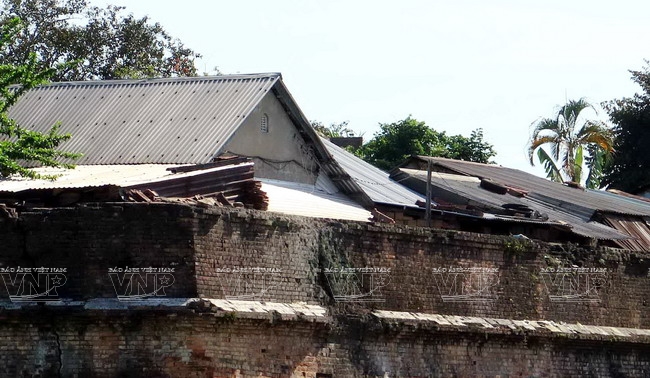 Due to the devastation of natural disasters, floods, wars and the indifference of people, many buildings in the complex of Hue monuments have been seriously damaged. Photo: Quoc Viet 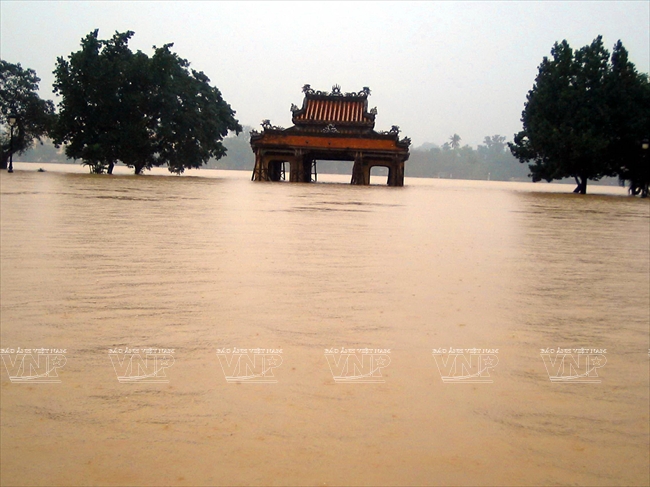 The relic of Phu Van Lau (Pavilion of Edicts) in the terrible flood of 1999. Photo: Quoc Viet  The terrible flood in 1999 seriously destroyed many buildings of the imperial citadel of Hue. In the photo: The Ngo Mon Gate is submerged in the floodwater. Photo: Quoc Viet |
| The Complex of Hue Monuments is the largest world cultural heritage site in Vietnam. It has more than 1,400 architectural monuments of 32 relic groups scattered in an area of tens of millions of square meters in Hue, two towns and two neighboring districts. |
In the 80s the entire imperial city of Hue was almost full of weeds. People in this area came to seek firewood, dug in the earth to find waste and graze cattle. They built houses, reclaimed land to cultivate vegetables and crops and did many jobs to earn a living. As a result, the deteriorated architectural works became more desolate and ruined.
Over time, these works were more and more damaged, and were even at risk of complete collapse if they were not protected in time.
A journey to rescue the heritage of Hue residents
Shortly after UNESCO recognised the Complex of Hue Monuments as a World Cultural Heritage Site, the authorities of Thua Thien Hue Province assigned the Hue Monuments Conservation Centre to develop a plan to restore, embellish and conserve this huge heritage site.
Under UNESCO’s regulations, after the Complex of Hue Monuments was recognised as a World Heritage Site, every two years UNESCO inspected the restoration and preservation of this heritage site. From 2006 to 2012, Hue annually submitted a report on the restoration and preservation of the heritage site to UNESCO and received high praise from the organisation. Therefore, in 2013 UNESCO took the Hue monuments off the list of heritage sites which should be monitored. UNESCO has repeatedly asked Hue to send experts to join the International Council on Monuments and Sites (ICOMOS) under UNESCO’s World Heritage Committee, but for many different reasons, Hue has not yet sent the experts to join this prestigious organisation.
Over 22 years since the Complex of Hue Monuments was recognised as a World Cultural Heritage Site by UNESCO, the Hue Monuments Conservation Centre has done a huge job of restoration. It has restored and embellished hundreds of important architectural items, including the citadel area like Ngo Mon, Thai Hoa Palace, Hien Lam Cac, The Mieu, Dien Tho Palace, Duyet Thi Duong, Truong Sanh Palace, Tu Phuong Vo Su Palace and Truong Lang system (a long corridor in Tu Cam Thanh).
 Introducing tourists to the scale model of the complex of Hue monuments. Photo: Hoang Ha/VNP 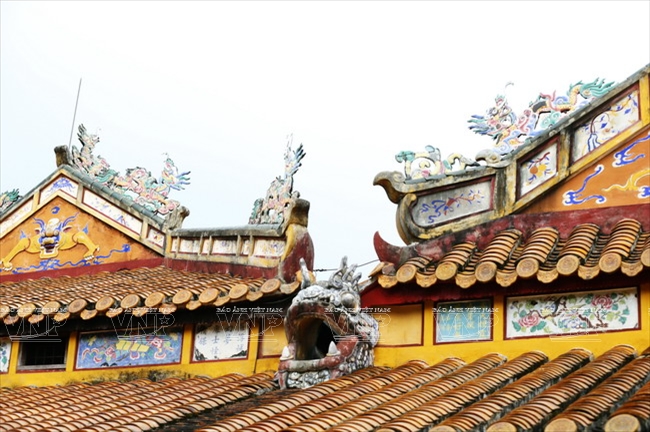 Many architectural details of the Complex of Hue Monuments have been restored to resemble those in the past. Photo: Hoang Ha/VNP 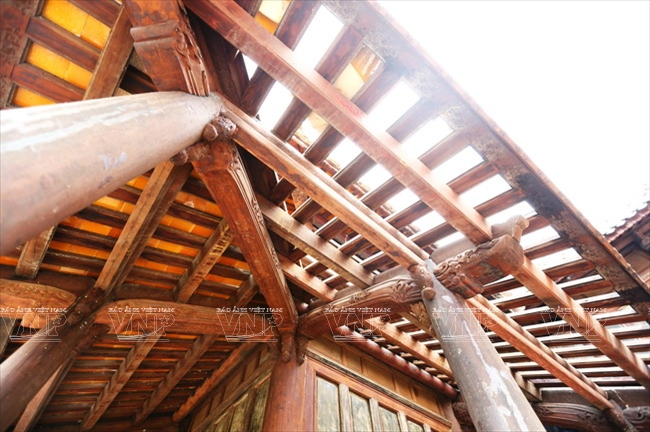 The relic of Trieu To Mieu is under restoration. Photo: Hoang Ha/VNP 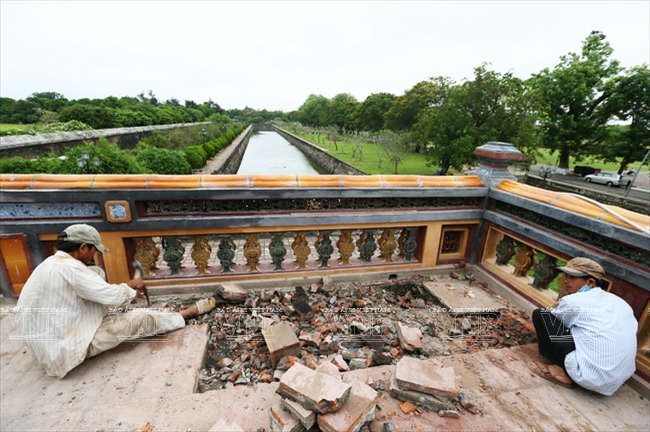 Hue artisans repair the floor of Ngu Phung Pavilion. Photo: Hoang Ha/VNP 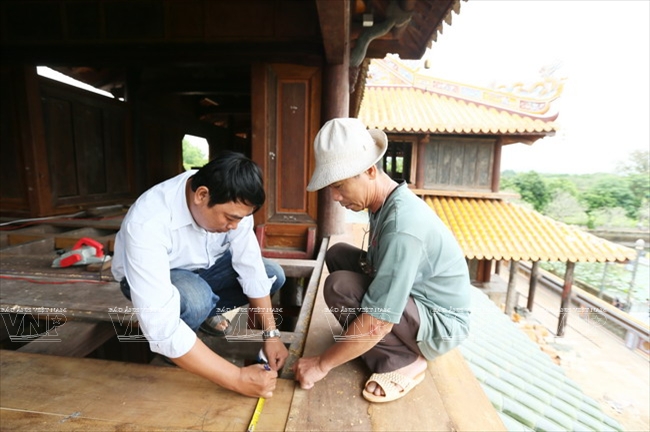 In 2015, the Hue Monuments Conservation Centre mobilised all human and financial resources, experts and skilled artisans nationwide to restore the Ngo Mon Gate-Ngu Phung Pavilion, a large relic in the complex of Hue monuments. Photo: Hoang Ha/VNP 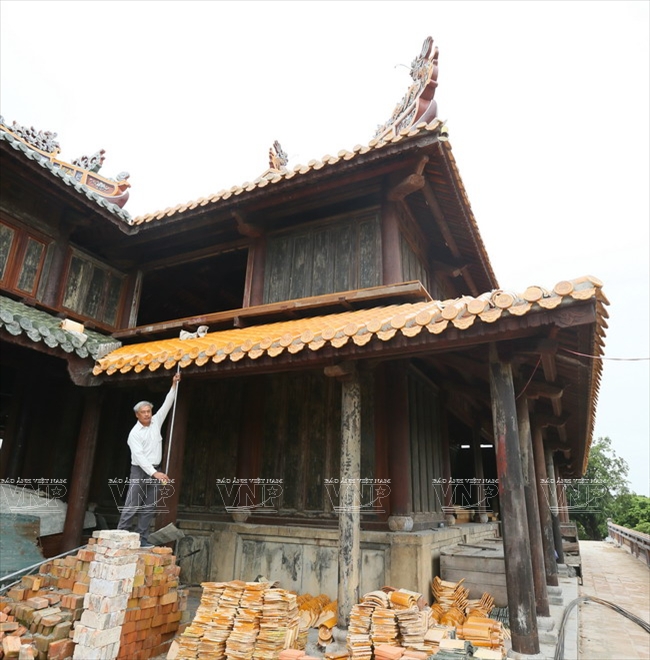 90 years after the restoration on the occasion of congratulating King Khai Dinh (1916-1925) on his longevity in 1923, the Ngo Mon Gate-Ngu Phung Pavilion was under restoration of a large scale. Photo: Hoang Ha/VNP 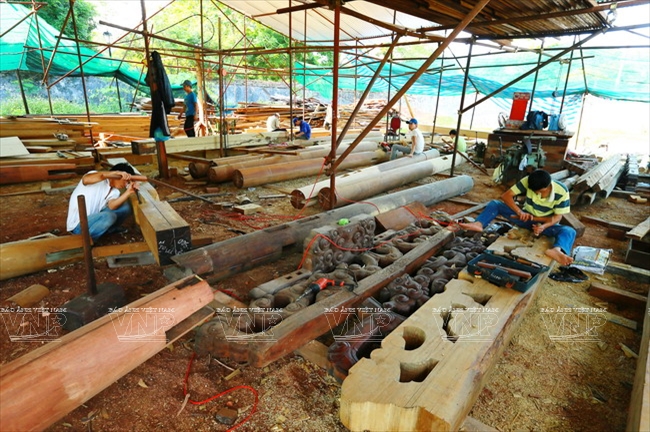 The relic of Trieu To Mieu is restored by a modern method using the technology of Japan. Photo: Hoang Ha/VNP 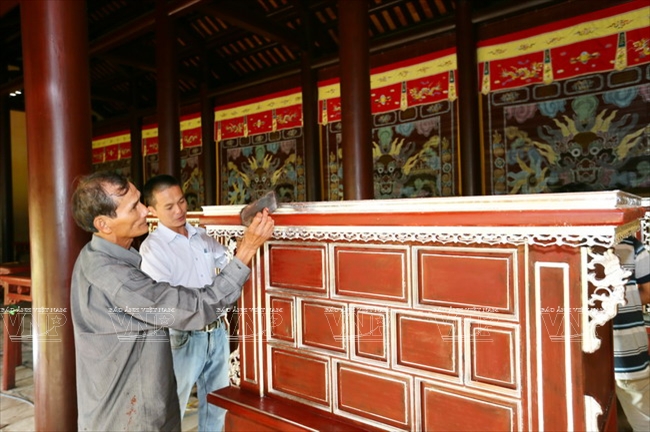 Hue artisans are restoring an incense table in the relic of Hien Nhon. Photo: Hoang Ha/VNP 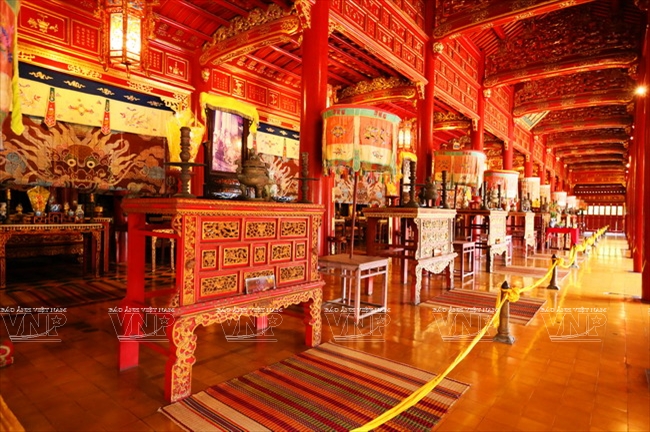 The inner The Mieu area, where the Nguyen Kings are worshiped, after being restored. Photo: Hoang Ha/VNP  The inner palace of Thai Hoa, where the Nguyen Kings had audience, after being restored. Photo: Hoang Ha/VNP 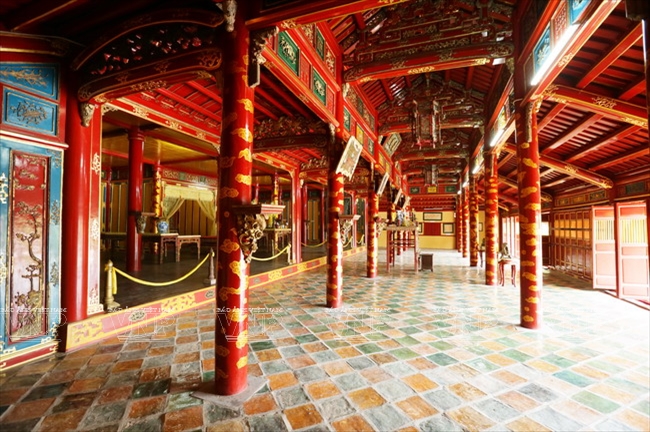 The restoration of the relic of Bieu Duc in Thien Tu Tomb, where the ancestral tablets of King Thieu Tri and Queen Tu Du is placed, was completed in 2011. Photo: Hoang Ha/VNP  The gate of the tomb of King Gia Long, the first king of the Nguyen Dynasty, has been successfully restored. Photo: Hoang Ha/VNP  Thai Hoa Palace, where the Nguyen Kings had audience, seen from Ngu Phung Pavilion. Photo: Hoang Ha/VNP |
Fortunately, the Imperial Citadel of Hue has preserved many precious cultural heritage sites of Vietnam, including the complex of architectural structures with many palaces, pavilions, temples and a system of ramparts and defensive fortress of the royal architecture of the Nguyen court in the early 19th century. The integrity of the urban planning and construction design has made Hue a rare model of urban planning at the end of the feudal period in East Asia.
(Dr. Phan Thanh Hai, Director of the Hue Monuments Conservation Centre) |
According to Dr. Phan Thanh Hai, Director of the centre, over nearly a century, under the harsh weather and the devastation of the bombing, many items, especially the wooden components have been seriously degraded. The current restoration includes not only repairs and protection but also the extension of the life of this important work.
The centre has mobilised a contingent of the most skilled professionals, artisans and craftsmen from Hue and the country, including foreign experts and using the most modern technology, to restore Ngo Mon.
Hue has applied the world’s optimal restoration technology. It is the technology of Japan, a country experienced in the restoration of ancient architectural works, especially the wooden works like those of the Hue court. Thanks to this technology, the experts can disassemble all components that should be repaired to check and work out measures to deal with the damage inside the structures.
According to Tran Van Huong who is in charge of Ngo Mon restoration technology, the process of restoration is strictly supervised by the Hue Monuments Conservation Centre to ensure that all details, even the smallest details, be exactly the same as the original. If very small items, such as the brass rivets used to assemble the wooden trusses, are improperly assembled, the supervisors require reassembling them, even though these items are hidden.
In 2014, in implementing the “Plan for conservation and promotion of the values of Hue monuments in the 2010-2020 period” according to Decision 1880/QD-TTg of the Prime Minister, the Hue Monuments Conservation Centre restored 17 monuments with a total investment capital of 90 billion dong.
As planned, in 2015 the centre will restore 22 more monuments with a total investment capital of about 150 billion dong. Among them there are the tombs of the kings of the Nguyen Dynasty, such as Kings Gia Long, Minh Mang, Thieu Tri and Tu Duc. These are great architectural structures with special historical, architectural and artistic values and distinct personalities of each king.
The world joins hands with Hue
Since UNESCO recognised the Complex of Hue Monuments as a World Cultural Heritage Site, many governments and 26 international organisations have granted nearly 10 million dollars to the Hue Monuments Conservation Centre to restore and preserve the monuments.
Recently, the International Support Fund of UNESCO has funded the programme on “strengthening the management capacity for the Complex of Hue Monuments” with 29,390 dollars during 2014 - 2015; the US Ambassadors Fund for Cultural Preservation (AFCP) of the US Department of State has funded two projects in the Imperial City of Hue with nearly 730,000 dollars; the Lao Government has granted 400m3 of ironwood, equivalent to 200,000 dollars; and the Rhone Polenc Chemical Company (France) provided 1 million dollars and anti-termite technical advice to preserve the projects of Hien Lam Cac and Dai Noi. In addition to the material support, many countries such as Poland, Germany and Japan have also sent experts to assist Hue.
 The signing ceremony of a cooperation document between the Hue Monuments Conservation Centre and the National Centre for Korean Traditional Performing Arts. Photo: Quoc Viet 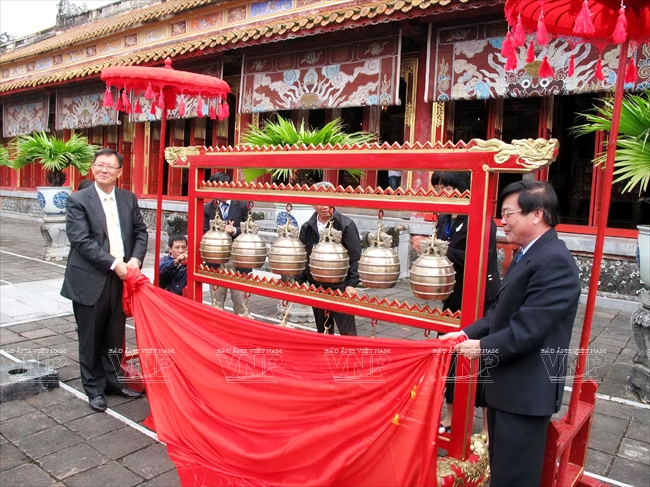 The National Centre for Korean Traditional Performing Arts presents a set of court music bells to the Hue Monuments Conservation Centre for display in the The Mieu area. Photo: Quoc Viet 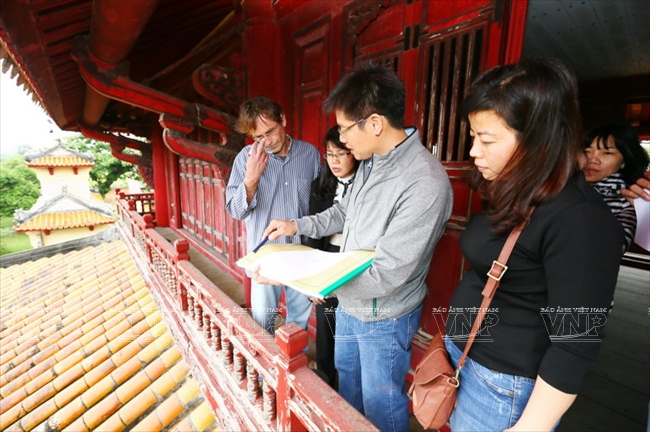 Dr. Phan Thanh Hai, Director of the Hue Monuments Conservation Centre and a French expert carry out a survey of the imperial citadel of Hue. Photo: Hoang Ha/VNP 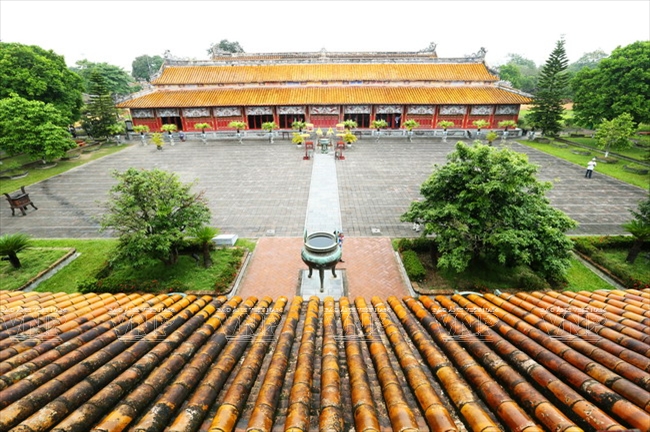 A panoramic view of The Mieu area where the Nguyen Kings are worshiped. Photo: Hoang Ha/VNP |
| So far, the Hue Monuments Conservation Centre has repaired and restored 132 monuments in the Complex of Hue Monuments which has been recognised as a World Cultural Heritage site by UNESCO. Most of the monuments are preserved with measures to prevent the leaks, collapse, termites and intrusion of plants and reinforce and replace the damaged parts. |
For a methodical, professional and long-term restoration and preservation of the monuments, the Hue Monuments Conservation Centre is planning to invite international experts to help Hue develop a strategic management programme with a vision to 2030.
It can be said that Hue residents have a very special sentiment for the heritage bequeathed by their forefathers. That may be the reason why they are deeply grateful to those who have contributed to Hue. In a solemn place in the monuments area they have built an altar dedicated to architect Kazik, a famous Polish architect who died in 1997 while helping restore and repair each brick in Dai Noi.
Story: Thanh Hoa & Quoc Viet
Photos: Hoang Quang Ha, Quoc Viet & Files
Photos: Hoang Quang Ha, Quoc Viet & Files
phamtrangnhung

